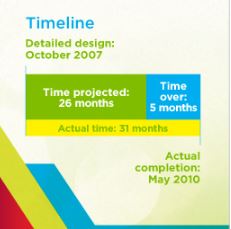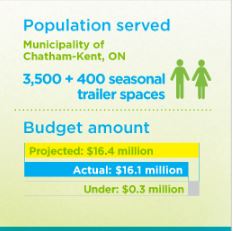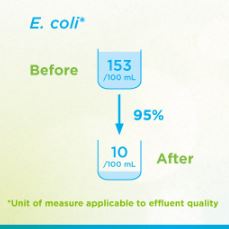This is part of a series of case studies on wastewater projects funded by the FCM's Green Municipal Fund. Each case study provides technical information, project details and tips on best practices.
Project overview
To improve treatment capacity and discharge quality, the Municipality of Chatham-Kent, ON, constructed a new wastewater treatment plant, featuring extended aeration-activated sludge treatment, at the site of Ridgetown's existing aerated lagoon facility. The project team installed a new raw sewage pump station, adapted two of the existing lagoon cells to store biosolids and handle excess wet weather flows, and shut down the lagoon cells that were no longer needed. The new facility also provides tertiary treatment using sand filters and ultraviolet disinfection.



Reasons for the project
- The municipality needed to increase the capacity of its wastewater treatment system and meet Ontario Ministry of the Environment and Climate Change targets for reducing E. coli in effluent.
Best practices and key lessons
The municipality's experience with this project demonstrates some best practices and key lessons that can inform similar projects.
Develop a comprehensive training and change management plan
- Public Utilities Commission operating staff were involved from the consulting phase to ensure a smooth start-up of the new facility.
Communicate with relevant government bodies at the planning stage
- Liaising early in the planning stage with the local conservation authority could help alleviate delays in latter stages of the project.
Plan for contingencies and weather
- As much as possible, schedule construction work for warmer months.
Project benefits
This project yielded a number of environmental, social and economic benefits.
Environmental benefits
- Improved wastewater quality: Levels of E. coli, phosphorus and ammonia are reduced.
- Reduced hazardous residuals: Upgraded tertiary treatment now features sand filtration and UV disinfection, resulting in cleaner, chlorine-free effluent.
- Biodiversity and ecosystem protection: Improved water quality supports the maintenance and expansion of habitat.
Social benefits
- Improved public health: Safer and cleaner discharge into streams, minimized periodic odour emissions and reduced noise disturbance ultimately result in a healthier environment for residents.
- Improved staff health and safety: Operators no longer need to enter a confined space to access the pump station.
- Greater opportunity for recreational activities: A healthier water flow supports recreational uses of downstream areas, including Gawne Drain, Lower Thames Valley and Lake St. Clair.
- Improved service delivery: The new facility can operate in all seasons and has extra capacity for emergency situations.
- Opportunity for public education and awareness: Public tours of the facility are available to help community members understand the value of sewage treatment. In addition, sludge samples are provided to the University of Guelph for student lab work.
- Improved neighbourhood aesthetics: Relocation of the facility provides a buffer between the Mitton Industrial Park and nearby residential properties.
Economic benefits
- Avoided capital expenses: Savings resulted from locating the facility in an existing lagoon and re-using as much equipment as possible.
- Increased job creation or retention: Municipal jobs were retained and additional workloads created to meet staffing requirements for the operation of the new wastewater treatment plant.
- Increased potential to attract new businesses: Greater storage and treatment capacity and year-round operation can better support industrial and other commercial development.
- Increased potential to attract new residents: Greater storage and treatment capacity and year-round operation can better support community growth.
- Local economy stimulus: The plant is now able to accept and properly treat septage from haulers. This provides a new source of revenue for the municipality.
- Use of feasibility tools: The municipality used full-cost accounting and evaluated design choices based on the life-cycle costs over the long term.
- Demand management: Demand-side policies and programs, including the municipality's policies for water use restrictions and sewer use, encourage efficient resource management.
- Simplified staff operations: A SCADA (supervisory control and data acquisition) system allows operators to make adjustments remotely and makes data monitoring more reliable and frequent.
Technical highlights
This project was a new facility. Technical highlights are current as of 2012.
Municipal population: 103,671
Urban/rural: urban
Treatment
- Before: Facultative lagoon
- After: Extended aeration-activated sludge
Disinfection
- Before: None - 153 CFU (Colony Forming Unit) /100 mL
- After: UV disinfection system - 10 CFU/100 mL
Biosolids management: Biosolids are left in the lagoon
Annual average daily flow (AADF)
- Before: 1.3 MLD (million litres per day)
- After: 1.5 MLD
Design capacity
- Before: 1.5 mg/L
- After: 2.3 mg/L
Per cent of total capacity used for AADF
- Before: 83 per cent
- After: 64 per cent
Total suspended solids (TSS)
- Before: 5.0 mg/L
- After: 4.7 mg/L
Biochemical oxygen demand (BOD)
- Before: 2.4 mg/L
- After: 2.1 mg/L
Project contact information
Rob Bernardi
Facilities & Systems Manager, Water & Wastewater Services
Municipality of Chatham-Kent, ON
T. 519-436-0119, ext. 306
Want to explore all GMF-funded projects? Check out the Projects Database for a complete overview of funded projects and get inspired by municipalities of all sizes, across Canada.


